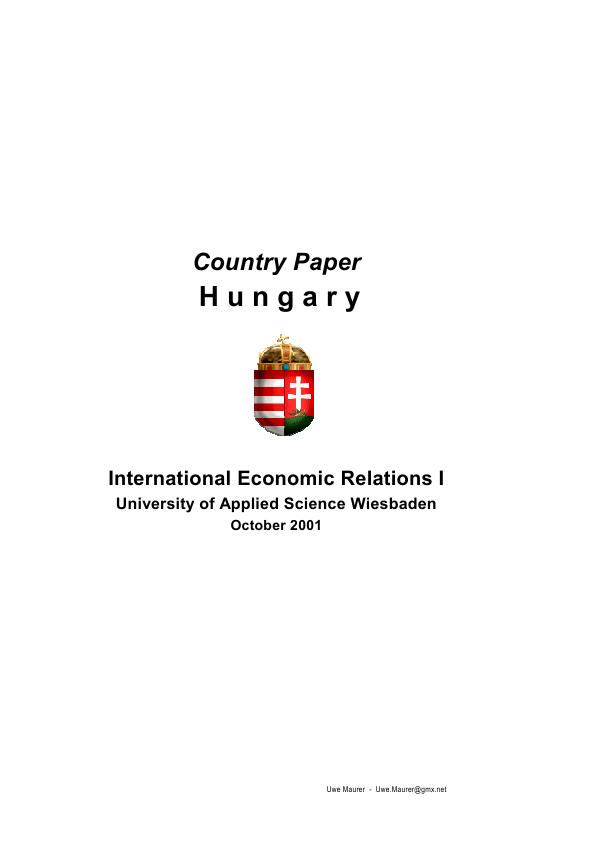Introduction
This country paper has been written for educational reasons. It is part of the class ‘International Economic Relations I’ – University of Applied Science Wiesbaden of winter 2001. It is attended to
the former socialist country Hungary, which underwent a transition from a socialistic to a democratic country. Mainly it throws light on the question if the simultaneous economical transition - from a planned to a market economy has been successful. Successful means if the country is able to catch up with economical leading countries. ‘What matters is the whole package of policies, financial and technical assistance and dept relief if necessary.’(1)
[...]
_____
1 cf. “Globalization: Threat or Opportunity?”, http://www.imf.org/external/np/exr/ib/2000/041200.htm; International Monetary
Fund Issued Brief; Washington 2000; p. 7f
Inhaltsverzeichnis (Table of Contents)
- The state Hungary..
- Brief Overview
- History
- Geographical Overview
- Population & Culture
- Economic frame
- National Institutions
- State Authorities
- Educational system
- Health system
- Welfare system
- Infrastructure
- Transport
- Telecommunication
- Media
- Energy
- Economic Structure
- Agriculture & forestry
- Mining & Semi-Processing
- Industry, Manufacturing & engineering
- Financial Sector
- Tourism
- National Institutions
- Economy Policy...
- Fiscal Policy
- Tax System
- Monetary Policy
- Privatisation
- Dual economy
- Sectorial dualism
- Regional dualism
- Ownership dualism
- FDI
- SME
- Széchenyi Plan
- Economic Performance.
- GDP
- Unemployment
- Inflation
- Investment
- Private consumption
- Sectors
- International Economic Affairs
- Import & Export
- Current account balance
- Foreign Dept
- Reserves and exchange rate
- Economical Outlook
Zielsetzung und Themenschwerpunkte (Objectives and Key Themes)
This country paper explores the economic transition of Hungary from a socialist to a democratic and market-oriented economy. The paper assesses the success of this transition by examining whether Hungary has been able to catch up with economically leading countries. The paper also analyzes the impact of economic policies, financial and technical assistance, and debt relief on Hungary's economic development. Key themes include:- Hungary's transition from a planned to a market economy.
- The impact of economic policies on Hungary's economic performance.
- The role of international economic relations in Hungary's economic development.
- Hungary's position in the global economy.
- Hungary's economic outlook and future prospects.
Zusammenfassung der Kapitel (Chapter Summaries)
The first part of the paper provides a historical, geographical, and cultural overview of Hungary. Chapter two focuses on the political, educational, health, and infrastructural systems in Hungary. Chapter three summarizes the economic policy of Hungary, including its fiscal policy, tax system, monetary policy, privatization, dual economy, FDI, SME, and Széchenyi Plan. Chapter four examines the economic performance of Hungary, looking at factors such as GDP, unemployment, inflation, investment, and private consumption. Chapter five explores Hungary's international economic affairs, including import and export, current account balance, foreign debt, reserves, and exchange rates.Schlüsselwörter (Keywords)
Hungary, economic transition, market economy, economic performance, international economic relations, economic policy, GDP, unemployment, inflation, investment, private consumption, import and export, current account balance, foreign debt, reserves, exchange rate, economic outlook.- Quote paper
- Uwe Maurer (Author), 2001, Country Paper Hungary, Munich, GRIN Verlag, https://www.grin.com/document/2005



